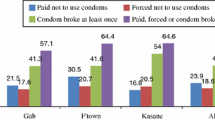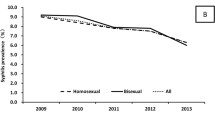Abstract
We assessed HIV and STI prevalence, risk behaviors and factors associated with HIV infection in men who have sex with men (MSM) in Guayaquil, Ecuador. Respondent-driven sampling was used to recruit 400 MSM in 2011–2012. Participants completed a computer-assisted self-interview and provided blood samples. Statistical analysis accounted for differential probability of selection and for recruitment patterns. HIV prevalence was 11.3 %, HSV-2 30.2 %, active syphilis 6.9 % and hepatitis B 1.2 %. In the previous 12 months, 84 % of MSM reported casual male sex partners and 25 % sex work. Only 48 % of MSM consistently used condoms with male partners and 54 % had ever been tested for HIV. Of 17 % of MSM reporting a female partner, consistent condom use was 6 %. HIV infection was associated with age 25 or older, active syphilis and homosexual self-identification. Findings suggest continuing HIV risk and a need to strengthen prevention and testing among MSM.
Resumen
Este estudio evaluó la prevalencia del VIH y otras ITS, los comportamientos de riesgo y los factores asociados a la infección por VIH en la población de hombres que tienen sexo con hombres (HSH) en Guayaquil, Ecuador. Se empleó el muestreo dirigido por participantes para reclutar a 400 HSH en 2011–2012. Los participantes completaron una entrevista auto-administrada asistida por computadora y aportaron muestras de sangre. El análisis estadístico tuvo en cuenta la probabilidad diferencial de selección y los patrones de reclutamiento. La prevalencia del VIH fue 11,3 %, VHS-2 30,2 %, sífilis activa 6,9 % y hepatitis B 1,2 %. En los últimos 12 meses, 84 % de los HSH refirieron parejas ocasionales hombres y 25 % haber ejercido trabajo sexual. Solo el 48 % usó el condón de manera consistente con sus parejas masculinas y el 54 % se había realizado la prueba del VIH alguna vez en la vida. Del 17 % que refirió haber tenido una pareja mujer, el uso consistente del condón fue del 6 %. La infección por el VIH se asoció con edad igual o mayor a 25 años, sífilis activa y auto-identificación como homosexual. Los resultados sugieren un riesgo continuado y la necesidad de fortalecer la prevención y el testeo entre HSH en la costa pacífica de Ecuador.
Similar content being viewed by others
References
Beyrer C, Baral SD, van Griensven F, Goodreau SM, Chariyalertsak S, Wirtz AL, et al. Global epidemiology of HIV infection in men who have sex with men. Lancet. 2012;380(9839):367–77.
Joint United Nations Programme on HIV/AIDS (UNAIDS). Global report: UNAIDS report on the global AIDS epidemic. 2013.
Beyrer C, Abdool Karim Q. The changing epidemiology of HIV in 2013. Curr Opin HIV AIDS. 2013;8(4):306–10.
Caceres C, Konda K, Pecheny M, Chatterjee A, Lyerla R. Estimating the number of men who have sex with men in low and middle income countries. Sex Transm Infect. 2006;82(Suppl 3):iii3–9.
ONUSIDA/OPS/UNICEF. Retos planteados por la epidemia del VIH en América Latina y El Caribe. 2009.
Joint United Nations Programme on HIV/AIDS (UNAIDS). The Gap Report. Geneva: UNAIDS. 2014.
Bautista CT, Sanchez JL, Montano SM, Laguna-Torres A, Suarez L, Sanchez J, et al. Seroprevalence of and risk factors for HIV-1 infection among female commercial sex workers in South America. Sex Transm Infect. 2006;82(4):311–6.
Rodríguez CM, Marques LF, Touzé G. HIV and injection drug use in Latin America. AIDS. 2002;16:S34–41.
Mathers BM, Degenhardt L, Phillips B, Wiessing L, Hickman M, Strathdee SA, et al. Global epidemiology of injecting drug use and HIV among people who inject drugs: a systematic review. Lancet. 2008;372(9651):1733–45.
Organización Panamericana de la Salud. Salud en las Américas: edición de 2012. Washington: Panorama regional y perfiles de países; 2012.
Sanchez-Gomez A, Grijalva MJ, Silva-Aycaguer LC, Tamayo S, Yumiseva CA, Costales JA, et al. HIV and syphilis infection in pregnant women in Ecuador: prevalence and characteristics of antenatal care. Sex Transm Infect. 2014;90(1):70–5.
Programa Nacional de VIH/Sida e ITS. Análisis de la situación del VIH en Ecuador. Quito: Ministerio de Salud Pública de Ecuador. 2010.
Montano SM, Sanchez JL, Laguna-Torres A, Cuchi P, Avila MM, Weissenbacher M, et al. Prevalences, genotypes, and risk factors for HIV transmission in South America. J Acquir Immune Defic Syndr. 2005;40(1):57–64.
Jacobson JO, Sanchez-Gomez A, Montoya O, Soria E, Tarupi W, Urquizo MC, et al. A continuing HIV epidemic and differential patterns of HIV-STI risk among MSM in Quito, Ecuador: an urgent need to scale up HIV testing and prevention. AIDS Behav. 2014;18(1):88–98.
Wechsler H, Dowdall GW, Davenport A, Rimm EB. A gender-specific measure of binge drinking among college students. Am J Public Health. 1995;85(7):982–5.
UNAIDS. Global AIDS Response progress reporting: monitoring the 2011 political declaration on HIV/AIDS: guidelines on construction of core indicators: 2012 reporting. Geneva. 2011.
Heckathorn DD. Respondent-driven sampling: a new approach to the study of hidden populations. Soc Probl. 1997;44(2):174–99.
Heckathorn DD. Respondent-driven sampling II: deriving valid population estimates from chain-referral samples of hidden populations. Soc Probl. 2002;49(1):11–34.
Salganik MJ, Heckathorn DD. Sampling and estimation in hidden populations using respondent-driven sampling. Sociol Methodol. 2004;34(1):193–240.
Schonlau M, Liebau E. Respondent driven sampling. Stata J. 2012;12(1):72–93.
Damacena GN, Szwarcwald CL, de Souza PR Jr, Dourado I. Risk factors associated with HIV prevalence among female sex workers in 10 Brazilian cities. J Acquir Immune Defic Syndr. 2011;57(Suppl 3):S144–52.
Spiller M. Regression modeling of respondent-driven sampling data. San Francisco: American Sociological Association Annual Meeting; 2009.
White H. Maximum likelihood estimation of misspecified models. Econometrica. 1982;50:1–25.
Sullivan PS, Salazar L, Buchbinder S, Sanchez TH. Estimating the proportion of HIV transmissions from main sex partners among men who have sex with men in five US cities. AIDS. 2009;23(9):1153–62.
Goodreau SM, Peinado J, Goicochea P, Vergara J, Ojeda N, Casapia M, et al. Role versatility among men who have sex with men in urban Peru. J Sex Res. 2007;44(3):233–9.
Baggaley RF, White RG, Boily MC. HIV transmission risk through anal intercourse: systematic review, meta-analysis and implications for HIV prevention. Int J Epidemiol. 2010;39(4):1048–63.
Grulich AE, Zablotska I. Commentary: probability of HIV transmission through anal intercourse. Int J Epidemiol. 2010;39(4):1064–5.
Rehm J, Shield KD, Joharchi N, Shuper PA. Alcohol consumption and the intention to engage in unprotected sex: systematic review and meta-analysis of experimental studies. Addiction. 2012;107(1):51–9.
Vosburgh HW, Mansergh G, Sullivan PS, Purcell DW. A review of the literature on event-level substance use and sexual risk behavior among men who have sex with men. AIDS Behav. 2012;16(6):1394–410.
Proyecto Programa Anti-Drogas Ilícitas de la Comunidad Andina—PRADICAN. II Estudio Epidemiológico Andino sobre Consumo de Drogas en la Población Universitaria. Informe Regional, 2012. 2013.
Inter-American Drug Abuse Control Commission. Report on drug use in the Americas. Washington; 2011.
Adam PC, de Wit JB, Toskin I, Mathers BM, Nashkhoev M, Zablotska I, et al. Estimating levels of HIV testing, HIV prevention coverage, HIV knowledge, and condom use among men who have sex with men (MSM) in low-income and middle-income countries. J Acquir Immune Defic Syndr. 2009;52(Suppl 2):S143–51.
Ministerio de Salud Pública del Ecuador. Plan Estratégico Multisectorial de la Respuesta Nacional al VIH/SIDA 2007–2015.
Marks G, Crepaz N, Janssen RS. Estimating sexual transmission of HIV from persons aware and unaware that they are infected with the virus in the USA. AIDS. 2006;20(10):1447–50.
Lama JR, Lucchetti A, Suarez L, Laguna-Torres VA, Guanira JV, Pun M, et al. Association of herpes simplex virus type 2 infection and syphilis with human immunodeficiency virus infection among men who have sex with men in Peru. J Infect Dis. 2006;194(10):1459–66.
Creswell J, Guardado ME, Lee J, Nieto AI, Kim AA, Monterroso E, et al. HIV and STI control in El Salvador: results from an integrated behavioural survey among men who have sex with men. Sex transm Infect. 2012;88(8):633–8.
Zoni AC, Gonzalez MA, Sjogren HW. Syphilis in the most at-risk populations in Latin America and the Caribbean: a systematic review. Int J Infect Dis. 2013;17(2):e84–92.
Karumudi UR, Augenbraun M. Syphilis and HIV: a dangerous duo. Expert Rev Anti Infect Ther. 2005;3(5):825–31.
Zetola NM, Klausner JD. Syphilis and HIV infection: an update. Clin Infect Dis. 2007;44(9):1222–8.
Beyrer C, Trapence G, Motimedi F, Umar E, Iipinge S, Dausab F, et al. Bisexual concurrency, bisexual partnerships, and HIV among Southern African men who have sex with men. Sex Transm Infect. 2010;86(4):323–7.
Sanders EJ, Graham SM, Okuku HS, van der Elst EM, Muhaari A, Davies A, et al. HIV-1 infection in high risk men who have sex with men in Mombasa, Kenya. AIDS. 2007;21(18):2513–20.
Fernandez-Davila P, Salazar X, Caceres CF, Maiorana A, Kegeles S, Coates TJ, et al. Compensated sex and sexual risk: sexual, social and economic interactions between homosexually- and heterosexually-identified men of low income in two cities of Peru. Sexualities. 2008;11(3):352–74.
Ghanem KG, Hutton HE, Zenilman JM, Zimba R, Erbelding EJ. Audio computer assisted self interview and face to face interview modes in assessing response bias among STD clinic patients. Sex Transm Infect. 2005;81(5):421–5.
Simoes AA, Bastos FI, Moreira RI, Lynch KG, Metzger DS. A randomized trial of audio computer and in-person interview to assess HIV risk among drug and alcohol users in Rio De Janeiro, Brazil. J Subst Abus Treat. 2006;30(3):237–43.
Catania JA, Gibson DR, et al. Methodological problems in AIDS behavioral research: influences on measuremient error and participation bias studies of sexual behavior. Psychol Bull. 1990;108(3):339–62.
Goel S, Salganik MJ. Assessing respondent-driven sampling. Proc Natl Acad Sci USA. 2010;107(15):6743–7.
Burt RD, Hagan H, Sabin K, Thiede H. Evaluating respondent-driven sampling in a major metropolitan area: comparing injection drug users in the 2005 Seattle area national HIV behavioral surveillance system survey with participants in the RAVEN and Kiwi studies. Ann Epidemiol. 2010;20(2):159–67.
McCreesh N, Frost S, Seeley J, Katongole J, Tarsh MN, Ndunguse R, et al. Evaluation of respondent-driven sampling. Epidemiology. 2012; 23(1):138.
Instituto Nacional de Estadística y Censos (INEC). Censo de Población y Vivienda. http://www.ecuadorencifras.gob.ec/base-de-datos-censo-2010/ (2010). Accessed 21 Jul 2014.
Kuhns LM, Kwon S, Ryan DT, Garofalo R, Phillips G, Mustanski BS. Evaluation of respondent-driven sampling in a study of urban young men who have sex with men. J Urban Health. 2014; [Epub ahead of print].
Kim E, Creswell J, Guardado M, Shah N, Kim A, Nieto A, et al. Correlates of bisexual behaviors among men who have sex with men in El Salvador. AIDS Behav. 2013;17(4):1279–87.
Pando MA, Balan IC, Marone R, Dolezal C, Leu CS, Squiquera L, et al. HIV and other sexually transmitted infections among men who have sex with men recruited by RDS in Buenos Aires, Argentina: high HIV and HPV infection. PLoS ONE. 2012;7(6):e39834.
UNAIDS. Location: connecting people faster to HIV services. Geneva: UNAIDS; 2013.
Acknowledgments
Funding for this study was provided by Ecuador’s National Ministry of Public Health, the United Nations Joint Programme on HIV/AIDS, the Pan American Health Organization and Fundación Ecuatoriana Equidad.
Conflicts of interest
None
Author information
Authors and Affiliations
Corresponding author
Rights and permissions
About this article
Cite this article
Sánchez-Gómez, A., Jacobson, J.O., Montoya, O. et al. HIV, STI and Behavioral Risk Among Men Who have Sex with Men in a Setting of Elevated HIV Prevalence Along Ecuador’s Pacific Coast. AIDS Behav 19, 1609–1618 (2015). https://doi.org/10.1007/s10461-014-0956-z
Published:
Issue Date:
DOI: https://doi.org/10.1007/s10461-014-0956-z




